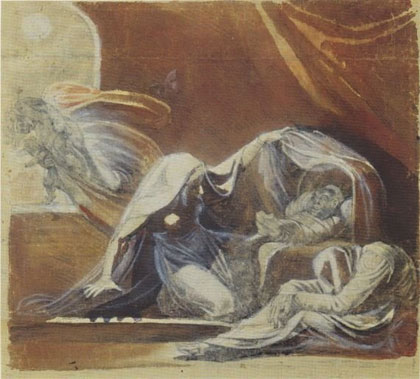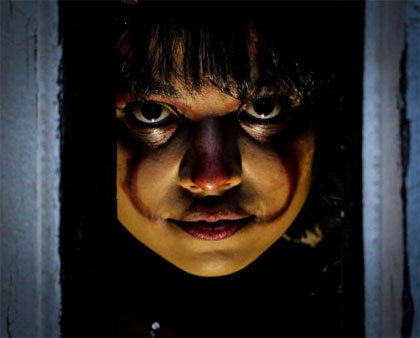
The Mysterious World of the Changelings of Europe
Brent Swancer December 18, 2021
In the lore of many regions throughout the world, there have always been those tales of spirits and supernatural creatures watching over our children, sometimes with benevolent eyes, sometimes not so much. Such mythologies play upon our inherit fears that something might happen to our children, and in the days of old these were very real supernatural threats. Among the numerous stories along these lines, some of the most well-known and sinister are those of the fairy folk who would come in to steal children and leave behind an imposter, by many accounts an abomination, most often referred to as changelings.
In the lore of numerous countries in the Europe and beyond, a changeling was more or less a copy of a child left by usually fairies, but sometimes elves, trolls, or some other spirit, depending on the culture, to replace a human child that they abducted. The fairies would sneak into homes, spirit away the human child, and leave an imitation version, a changeling, in its place, and this would be done for several different reasons, depending on the lore of a specific region. Sometimes it was because fairies coveted human children and wanted one for themselves, and indeed some human children were said to live out the rest of their days in the fairy realm. On other occasions it was to take a human child as a slave or servant, out of malice or revenge, or even as no more than a prank. Fairies might also take a human child if they thought they weren’t being cared for properly, or even because the changeling itself had requested to grow up in the human world, for instance some older fairies supposedly requested to be made into changelings in order to become young again and start life anew in the human world. The children taken were almost without fail the most beautiful, which is why in some traditions, such as those of Ireland, it was seen as bad luck to look at a baby with envy or praise its beauty too much, because this was thought to draw the fairies’ attention to it and make the child a target.
 Although they looked indistinguishable from a human child, once a child was replaced by a changeling there were varying ways to tell if they were an imposter, again depending on the region. In many traditions changeling children were likely to look pale and sickly, and may not grow up to be a normal size. They were often said to have long teeth, scraggly hair, or some hidden physical deformity or birth defect, such as extra toes. Changelings were said to have enormous appetites, eating far more than a normal human child of their size would, and they were also typically said to be more intelligent than a normal human child of their age. It was also said that they would demonstrate skills or abilities that their human doppelganger had not possessed, with psychic abilities often mentioned. They were often said to have an uncanny “offness” about their outward appearance, which was hard to put one’s finger on but would be unsettling to all who looked at them. Other traditions speak of the changeling becoming uglier with age. For instance in Wales, it was believed that the changeling would start out beautiful, but become ever more hideous as it grew up. People around the changeling child might also suffer physical effects, such as being unable to move their limbs, which was called being ‘fairy-struck.’ Changeling children were also commonly described as acting very oddly, as well as never smiling or laughing when people were watching, although they would do so when they thought they were alone, and many times changelings were mute or spoke very little. The English poet and topographer George Waldron, who lived in the Isle of Man during the early 18th century, would claim to have actually seen a changeling child, and described it as follows:
Although they looked indistinguishable from a human child, once a child was replaced by a changeling there were varying ways to tell if they were an imposter, again depending on the region. In many traditions changeling children were likely to look pale and sickly, and may not grow up to be a normal size. They were often said to have long teeth, scraggly hair, or some hidden physical deformity or birth defect, such as extra toes. Changelings were said to have enormous appetites, eating far more than a normal human child of their size would, and they were also typically said to be more intelligent than a normal human child of their age. It was also said that they would demonstrate skills or abilities that their human doppelganger had not possessed, with psychic abilities often mentioned. They were often said to have an uncanny “offness” about their outward appearance, which was hard to put one’s finger on but would be unsettling to all who looked at them. Other traditions speak of the changeling becoming uglier with age. For instance in Wales, it was believed that the changeling would start out beautiful, but become ever more hideous as it grew up. People around the changeling child might also suffer physical effects, such as being unable to move their limbs, which was called being ‘fairy-struck.’ Changeling children were also commonly described as acting very oddly, as well as never smiling or laughing when people were watching, although they would do so when they thought they were alone, and many times changelings were mute or spoke very little. The English poet and topographer George Waldron, who lived in the Isle of Man during the early 18th century, would claim to have actually seen a changeling child, and described it as follows:
Nothing under heaven could have a more beautiful face; but though between five and six years old, and seemingly healthy, he was so far from being able to walk, or stand, that he could not so much as move any one joint; his limbs were vastly long for his age, but smaller than an infant’s of six months; his complexion was perfectly delicate, and he had the finest hair in the world; he never spoke, nor cried, ate scarcely anything, and was very seldom seen to smile, but if any one called him a fairy-elf, he would frown and fix his eyes so earnestly on those who said it, as if he would look them through. His mother, or at least his supposed mother, being very poor, frequently went out a-charing, and left him a whole day together. The neighbours, out of curiosity, have often looked in at the window to see how he behaved when alone, which, whenever they did, they were sure to find him laughing and in the utmost delight. This made them judge that he was not without company more pleasing to him than any mortal’s could be; and what made this conjecture seem the more reasonable was, that if he were left ever so dirty, the woman at her return saw him with a clean face, and his hair combed with the utmost exactness and nicety.
For a long time, changelings were seen as a very real threat, with many families constantly on guard against their child being abducted and replaced by these doppelgangers, and as with many other supernatural creatures, there were various methods to keep the changelings away. A common theme in many regions was the use of iron, thought to have a powerful repelling effect against the creatures, with iron objects such as knives and scissors left around the child’s cot to keep them at bay. Other ways included constantly watching the child, laying the father’s clothes on the bed, keeping a fire constantly lit in the room, baptizing the child, and other strange customs such as placing urine around the bed. Most traditions also feature various charms, amulets, herbs, or salves that could be used to keep changelings away as well, but despite all of these precautions, there was never any certain guarantee that a child wouldn’t be taken and replaced by the fairies.
 In almost every tradition of changelings, they were not seen as a desirable or benevolent presence, mischievous at best and portents of misfortune, death, and ruin at worst. For this reason, if a changeling was spotted in a family, besides the parents just wanting their own child back, it was in their best interest to get rid of it before problems came their way, and there were various traditions for how to do this. In many countries, it was thought that torturing a changeling until it laughed would do the trick, causing it to leave and bring the human child back. In Ireland it was thought that throwing the changeling into a fireplace would cause it to jump up the chimney and return the human child. Indeed, many countries had the tradition of using fire or otherwise heating the changeling, such as in an oven in order to banish it. They could also be beaten and mistreated in order to force them to admit their true nature. In other traditions it was enough to simply trick the changeling into speaking or laughing by any means necessary, and there were certain rituals that could be carried out as well. If a family was lucky, the changeling would just get bored and go away on its own, although there were no guarantees that the human child it had replaced would ever be returned.
In almost every tradition of changelings, they were not seen as a desirable or benevolent presence, mischievous at best and portents of misfortune, death, and ruin at worst. For this reason, if a changeling was spotted in a family, besides the parents just wanting their own child back, it was in their best interest to get rid of it before problems came their way, and there were various traditions for how to do this. In many countries, it was thought that torturing a changeling until it laughed would do the trick, causing it to leave and bring the human child back. In Ireland it was thought that throwing the changeling into a fireplace would cause it to jump up the chimney and return the human child. Indeed, many countries had the tradition of using fire or otherwise heating the changeling, such as in an oven in order to banish it. They could also be beaten and mistreated in order to force them to admit their true nature. In other traditions it was enough to simply trick the changeling into speaking or laughing by any means necessary, and there were certain rituals that could be carried out as well. If a family was lucky, the changeling would just get bored and go away on its own, although there were no guarantees that the human child it had replaced would ever be returned.
Yet, even with all of these deterrents and weapons against the changeling threat, many families felt compelled to care for it simply because they were afraid that something bad would happen to their real child if they did not. On occasion, this could lead to the thankful changeling giving back the human child as a reward for their kindness, but usually the changeling would remain. In some cases, the changeling would be raised as the family’s child through to adulthood, with the changeling sometimes even forgetting what they really were and believing themselves to be human. In this case, the human child that they had replaced would live with the fairies forever, and would sometimes themselves forget that they had ever been human at all. There are many historical tales of changelings that grew up in human society. King Charles I of England (1600 – 1649) was reportedly rumored to have been a changeling, and there is also the tale of a woman named Bridget Cleary, who was murdered by her own husband in 1895 when he suspected her of being a changeling.
 The stories of changelings reverberate throughout the lore of many European countries, including the United Kingdom, Scandinavia, Poland, Spain, and others, and similar tales stretch out to Africa, Asia, and the Middle East. Why is it that such similar stories have managed to worm their way into these far-flung lands? One of the main theories in modern times is that this was a way of explaining and dealing with from infants born with birth defects, or deformed, developmentally disabled, or neurodivergentor children, as well as those with autism. In an age when there was little to medically or scientifically explain such things, this could have perhaps been a way to rationalize such children. The parents would see these defects and convince themselves that this couldn’t possibly be their own child, but rather an imposter left by supernatural forces. It is horrifying in a sense, as such folklore and beliefs likely led to countless instances of innocent children being mistreated, tortured, abandoned, or even killed. We may never truly know how such stories evolved, or why they remain so eerily similar across geographical and cultural divides, but they certainly play into every parent’s fears that something might happen to their child, and remain a curious area of strange lore with deep roots in mystery.
The stories of changelings reverberate throughout the lore of many European countries, including the United Kingdom, Scandinavia, Poland, Spain, and others, and similar tales stretch out to Africa, Asia, and the Middle East. Why is it that such similar stories have managed to worm their way into these far-flung lands? One of the main theories in modern times is that this was a way of explaining and dealing with from infants born with birth defects, or deformed, developmentally disabled, or neurodivergentor children, as well as those with autism. In an age when there was little to medically or scientifically explain such things, this could have perhaps been a way to rationalize such children. The parents would see these defects and convince themselves that this couldn’t possibly be their own child, but rather an imposter left by supernatural forces. It is horrifying in a sense, as such folklore and beliefs likely led to countless instances of innocent children being mistreated, tortured, abandoned, or even killed. We may never truly know how such stories evolved, or why they remain so eerily similar across geographical and cultural divides, but they certainly play into every parent’s fears that something might happen to their child, and remain a curious area of strange lore with deep roots in mystery.
MU*























